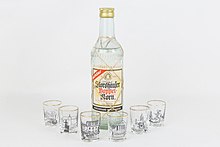
Back كورن (شراب) ARZ Kornbrand German Korn (licor) Spanish Korn (liqueur) French Kurn (sprit) FRR コルン Japanese Kornbrand Dutch Doppelkorn Polish
This article needs additional citations for verification. (February 2013) |


Korn (from German, "grain", pronounced [kɔʁn] , English "corn"), also known as Kornbrand or Kornbranntwein (English: "grain brandy" or "grain spirit"[1][2]), is a German colorless distilled beverage produced from fermented cereal grain seed.[3] The production of Korn uses only five grains: most of the production is based on rye or wheat; barley is mainly used to obtain the required malt for the brewing process; oats and buckwheat are rarely used. The addition of food colorings, flavorings, or sweeteners is not permitted. Korn is distilled to lower alcoholic proofs and less rigorously filtered than vodka, which leaves more of the cereal grain flavor in the finished spirit.
Korn must contain a minimum of 32% ABV (64 proof). Above 37.5% ABV (75 proof) it may be named Kornbrand, and the name Doppelkorn, with 38% ABV (76 proof), has been used in the market.
Korn is usually consumed neat in shot glasses, but is also popular with a soft drink mixer. In some places, a beer is often ordered together with a Kurzer ("short"), i.e., a shot glass of Korn. This combination is called in German a "Herrengedeck" (literally "gentlemen's place-setting"; English: "Boilermaker") in most parts of Germany. Fruit-flavored products made with Korn are available from some Korn manufacturers, though they are sold as liqueurs since Korn itself cannot be flavored.
Very strong Korn (80% ABV / 160 proof) is known as "Ansatzkorn" and is typically used to produce home-made liqueurs from fruits and herbs, such as Zirbenschnaps (liqueur flavoured with stone pine cones); this practice is particularly common in alpine regions. Such liqueurs are usually diluted to drinking strength before bottling. Like other neutral strong spirits, Ansatzkorn can also be used as a disinfectant for domestic use.
- ^ "EUR-Lex - 32008R0110 - EN". EUR-Lex - Access to European Union law.
- ^ 27 CFR 5.22
- ^ Lichine, Alexis (1987). Alexis Lichine's New Encyclopedia of Wines & Spirits (5th ed.). New York: Alfred A. Knopf. p. 292. ISBN 0-394-56262-3.